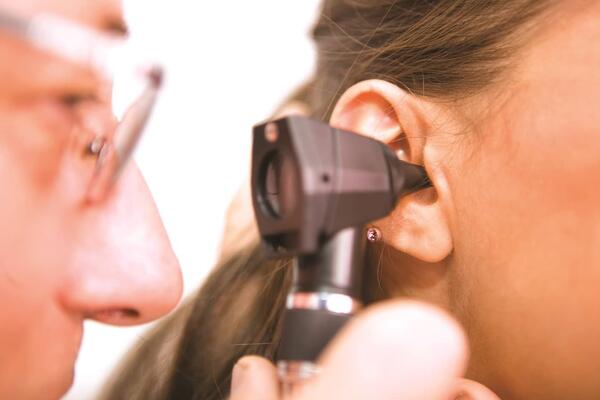Children and adults who are deaf or can’t hear much may be candidates for an implant. A cochlear implant is different from hearing aids. The device is surgically inserted and connected to the ear’s nerves to provide a sense of sound to a person.
CAMC’s Pediatric and Adult ENT team take a comprehensive, team-oriented approach to treating hearing loss. Our patients and their families work with a team of experts, including ENT surgeons, audiologists and auditory rehabilitation therapists throughout their entire experience – from diagnosis through rehabilitation.
What is a cochlear implant?
Cochlear implants are FDA-approved medical devices that are surgically placed to treat hearing loss. The implant itself is a small electronic device that electrically stimulates the cochlear nerve, which is used for hearing.
The device has two parts. One part sits behind the ear and picks up sounds with a microphone. It processes the sound and sends it to the second part of the implant, which is implanted in the inner ear during surgery. A thin wire and small electrodes leads to the cochlea, which is part of the inner ear. The wire sends signals to the auditory nerve, which sends sound impulses to the brain.
Whereas a hearing aid makes sounds louder and helps someone with some hearing loss, cochlear implants can help a person with very little to no hearing. The implant doesn’t restore hearing to normal, but it can help patients understand speech and noises around them.
What happens after the surgery?
A few weeks after the implantation surgery, the patient will return and the doctors will activate the new implant. A cochlear implant requires training and therapy after surgery during which time patients will learn how to care for the implant and how to use it properly.
Learning to use a cochlear implant will likely require visits with speech-language pathologists, audiologists, counselors and teachers, but with commitment, patients can have an improved quality of life.
Benefits of a Cochlear Implant
Cochlear implants benefit each patient differently. Some people can hear many sounds, and others may not notice a significant change.
A person may be able to:
- Hear different types of sounds – soft, medium and loud
- Understand speech without lip reading, or be helped with lip reading
- Talk on the phone, hear music or watch TV more easily
Alternatives to Cochlear Implants
Bone-Anchored Hearing Aid (BAHA)
The Bone Anchored Hearing Aid (BAHA) is a surgically-implanted device designed to help patients who have at least one inner ear that functions normally. Candidates have conductive hearing loss, which means their outer or middle ears do not transmit sound correctly, or they have complete hearing loss in one ear only.
Most conventional hearing aids transmit sound through air conduction; but the BAHA stimulates the inner ear (cochlea) by transmitting sounds waves through the bones in the skull (called bone conduction), bypassing the outer and middle ear.
The bone-anchored device consists of three parts:
- Titanium implant
- External abutment or magnet to attach the external part of the device
- Sound processor and removable microphone
During a BAHA procedure, a titanium implant is placed in the skull behind the non-functioning ear. An abutment connects the sound processor with the implant in the bone. For hearing, the sound processor transmits sound vibrations through the external abutment to the titanium implant. The vibrating implant sets up vibrations within the skull and inner ear that stimulate the nerve fibers of the inner ear, which allows for hearing.
How do I know which implant will work best?
Your otolaryngologist (ENT) will work with you to determine which implant might best meet your needs. The team will also explain in more detail how to prepare for surgery and for life after the implant.

CAMC Ear, Nose and/or Throat (ENT) Physicians
If you or your children have been diagnosed with medical problems related to the ear, nose and/or throat (ENT), our skilled physicians are here to provide the highest level of care in a compassionate, friendly environment.
What Sets Us Apart
What Sets Us Apart
From basic to the most advanced needs, we provide a full range of ENT services, including conditions and disorders related to:
- Ears
- Infections
- Hearing Loss
- Cochlear Implant
- Nose and Throat
- Sinus
- Tonsils and Adenoids
- Neck (masses, cysts)
- Voice Box (larynx)
- Thyroid and Parathyroid
- Salivary Gland (parotid, submandibular)
- Allergies



